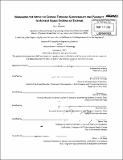| dc.contributor.advisor | Daniel E. Hastings. | en_US |
| dc.contributor.author | Mekdeci, Brian, 1976- | en_US |
| dc.contributor.other | Massachusetts Institute of Technology. Engineering Systems Division. | en_US |
| dc.date.accessioned | 2013-07-10T14:53:54Z | |
| dc.date.available | 2013-07-10T14:53:54Z | |
| dc.date.copyright | 2013 | en_US |
| dc.date.issued | 2013 | en_US |
| dc.identifier.uri | http://hdl.handle.net/1721.1/79550 | |
| dc.description | Thesis (Ph. D.)--Massachusetts Institute of Technology, Engineering Systems Division, 2013. | en_US |
| dc.description | Cataloged from PDF version of thesis. | en_US |
| dc.description | Includes bibliographical references (p. 195-202). | en_US |
| dc.description.abstract | As technology improves, traditional systems are being interconnected into larger systems of systems (SoS) that operate in diverse contexts, where numerous perturbations exist that threaten the ability of the SoS to deliver acceptable value to its diverse set of stakeholders. Furthermore, the systems of systems themselves can change form voluntarily or involuntarily in response to contextual variability or stakeholder whims. Various system properties, or "-ilities" have been defined that may help traditional systems provide value to stakeholders in spite of change, but they have not specifically addressed the issue of systems operating within larger systems of systems. This dissertation defines the concept of viability for engineered systems, as a likelihood that systems will satisfy their stakeholder needs over the system's expected lifetime, and identifies and develops strategies that system architects can use to create viable systems. The concept of viability helps system architects design systems that can survive contextual perturbations, whether they are from entities outside the traditional system boundary, or from other constituent systems within a SoS. In addition to external perturbations, this dissertation addresses the need to ensure that endogenous changes made to improve value delivery, do not inadvertently cause unintended interactions that harm the system overall. This is particularly a concern with the proliferation of systems of systems, and the recent drive towards making systems more changeable as a mechanism for value sustainment in dynamic environments. A new "ility", pliability, is introduced that specifies the limits on how a system can change, without "breaking" or violating an architecture that was intended and validated. Like changeability, pliability increases robustness by allowing systems to voluntarily change in response to dynamic contexts, and increases survivability and robustness by increasing the likelihood that unintentional changes are still within the set of allowable instances. It also distinguishes allowable changes from those that would require validation, reducing the effort required to get those changes approved by a diverse set of stakeholders. | en_US |
| dc.description.statementofresponsibility | by Brian Mekdeci. | en_US |
| dc.format.extent | 202 p. | en_US |
| dc.language.iso | eng | en_US |
| dc.publisher | Massachusetts Institute of Technology | en_US |
| dc.rights | M.I.T. theses are protected by
copyright. They may be viewed from this source for any purpose, but
reproduction or distribution in any format is prohibited without written
permission. See provided URL for inquiries about permission. | en_US |
| dc.rights.uri | http://dspace.mit.edu/handle/1721.1/7582 | en_US |
| dc.subject | Engineering Systems Division. | en_US |
| dc.title | Managing the impact of change through survivability and pliability to achieve viable systems of systems | en_US |
| dc.type | Thesis | en_US |
| dc.description.degree | Ph.D. | en_US |
| dc.contributor.department | Massachusetts Institute of Technology. Engineering Systems Division | |
| dc.identifier.oclc | 851391743 | en_US |
